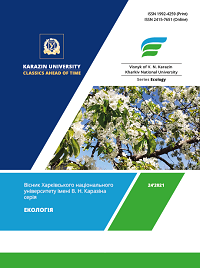Assessment of the Ecological and Geographical Condition of the Basin System Lakes Strilske (Hydrological Monument of Nature)
Abstract
There are presented a cartographic model of the spatial-typological structure of the lands of the lake catchment. Shooting and substantiation of its geoecological condition, bathymetric map of the lake and morphological-morphometric and hydrological calculations of the LBS. The hydrochemical parameters of the lake were analyzed according to the block of indicators of salt composition, tropho-saprobiological characteristics and substances of toxic action. The lithological composition and capacity of the bottom sediments of the lake are estimated, the graphs of radial migration of chemical elements and compounds at one of the probing points are constructed and the qualitative composition of the lake sapropel is substantiated. Using GIS technologies, a landscape map of the natural-aqual complex of the lake was built. Shooting and landscape-metometric assessment of its morphological structure.
The basin system has in the past undergone anthropogenic transformations as a result of reclamation nature management, which has limited the share of surface runoff into the lake. The littoral aqua facies of the lake suffer the greatest anthropogenic load, which is connected with the recreational activities of the seasonally functioning recreation center.
Downloads
Published
Issue
Section
License
Copyright (c) 2021 Мартинюк В. О., Андрійчук С. В.

This work is licensed under a Creative Commons Attribution 4.0 International License.
Authors reserve the right of attribution for the submitted manuscript, while transferring to the Journal the right to publish the article under the Creative Commons Attribution License. This license allows free distribution of the published work under the condition of proper attribution of the original authors and the initial publication source (i.e. the Journal)Authors have the right to enter into separate agreements for additional non-exclusive distribution of the work in the form it was published in the Journal (such as publishing the article on the institutional website or as a part of a monograph), provided the original publication in this Journal is properly referenced
The Journal allows and encourages online publication of the manuscripts (such as on personal web pages), even when such a manuscript is still under editorial consideration, since it allows for a productive scientific discussion and better citation dynamics (see The Effect of Open Access).

